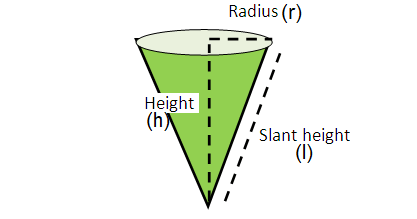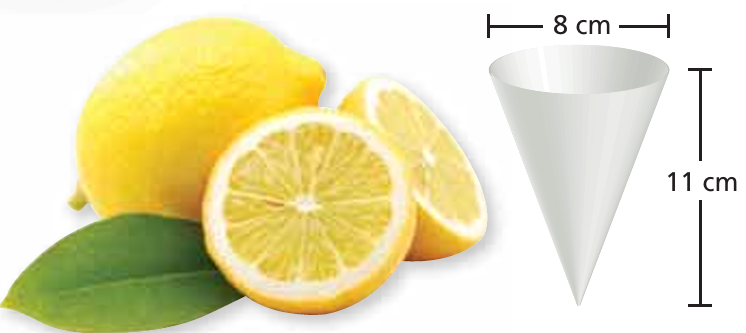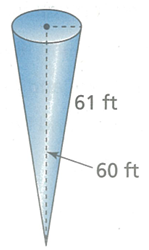VOLUME OF A CONE WORD PROBLEMS
Subscribe to our ▶️ YouTube channel 🔴 for the latest videos, updates, and tips.
The formula to find the volume of a cone is given by
V = 1/3 · πr2h cubic units

Problem 1 :
The height and diameter of a cone-shaped storage tank are 9 feet and 14 feet respectively. Find the volume of liquid the tank can hold. Round your answer to the integer, if necessary. Use the approximate of value of π, that is 3.14.
Solution :
Step 1 :
Because the tank is in the shape of cone, we can use the formula of volume of a cone to find volume of water the tank can hold.
Write the formula to find volume of a cone.
V = 1/3 · πr2h -----(1)
Step 2 :
To find the volume, we need the radius of the cone. But, the diameter is given, that is 14 ft. So, find the radius.
r = diameter / 2
r = 14/2
r = 7
Step 3 :
Substitute π ≈ 3.14, r = 7 and h = 9 in (1).
V ≈ 1/3 · 3.14 · 72 · 9
Simplify.
V ≈ 1/3 · 3.14 · 49 · 9
V ≈ 461.58
Round it to the nearest integer.
V ≈ 462
So, the volume of the clay is about 462 cubic inches.
Problem 2 :
A silo is shaped like a cone and contains wheat. The radius is 10 feet and the height is 15 feet. If the silo can release wheat from its bottom at the rate of 25 cubic feet per minute, how long would it take for the silo to empty fully ? Round your answer to the nearest minute. Use the approximate of value of π, that is 3.14.
Solution :
Step 1 :
To know how long it would take for the silo to empty fully, first we have to find the volume of wheat in the silo.
Because the silo is in the shape of cone, we can use the formula of volume of a cone to find volume of wheat the tank can hold.
Write the formula to find volume of a cone.
V = 1/3 · πr2h -----(1)
Step 2 :
Substitute π ≈ 3.14, r = 10 and h = 15 in (1).
V ≈ 1/3 · 3.14 · 102 · 15
Simplify.
V ≈ 1/3 · 3.14 · 100 · 15
V ≈ 1,570
So, the volume of wheat in the silo is about 1,570 feet.
Step 3 :
Silo can release wheat from its bottom at the rate of 25 cubic feet per minute.
To know how long it would take for the silo to empty 1,570 cubic feet of wheat, divide 1,570 by 25.
= 1,570 / 25
= 62.8
≈ 63
So, it would take about 63 minutes for the silo to empty fully.
Problem 3 :
You have 10 gallons of lemonade to sell. (1 gal ≈ 3785 cm3)

a. Each customer uses one paper cup. How many paper cups will you need?
b. The cups are sold in packages of 50. How many packages should you buy?
c. How many cups will be left over if you sell 80% of the lemonade?
Solution :
a)
1 gallon = 3785 cm3
10 gallons = 10 x 3785
= 37850 cm3
Capacity of paper cup = 1/3 · πr2h
radius = 4 cm and height = 10 cm
= 1/3 · π(4)2(10)
= 167.46 cm3
Number fo cups needed = 37850/167.46
= 226.02
Approximately 226 paper cups
b) One package will consists of 50.
To get 226, number of packages should buy = 226/50
= 4.52
approximately 5 packages.
c) 80% of lemonade = 80% of 37850
= 0.80(37850)
= 30280 cm3
number cups needed to sale 30280 cm3 cup of lemanode
= 30280/167.46
= 180.8
approximately 181 cups.
Remianing number of cups = 226 - 181
= 45 cups
Problem 4 :
If a cone shaped hole is 3 feet deep and the circumference of the base of the hole is 44 feet. What is the volume of the hole ?
Solution :
Circumferece of base = 44 feet
2πr = 44
height of cone = 3 feet
2 x 22/7 x r = 44
r = (44 x 7)/44
r = 7
Volume fo cone = 1/3 · πr2h
= 1/3 · (22/7) x 72x 3
= 22 x 7
= 154 ft3
So, the volume of the hole is 154 ft3.
Problem 5 :
A city engineer determines that 5500 cubic meters of sand will be needed to treat the roadways this winter. Does the city have enough sand to treat the roadways ?

Solution :
r = ?, slant height (l) = 37 m and height (h) = 35 m
r = √l2 - h2
= √372 - 352
= √144
r = 12 m
Quantity of sand = 1/3 · πr2h
= 1/3 · (22/7) x 122 x 35
= 110880/21
= 5280 m3
Quantity of sand required = 5500 cubic meter
So, the sand is enough.
Problem 6 :
A water tank is shaped line a cone shown.

a) How much water the tank hold.
b) If water is drained from the tank to fill smaller tanks that each hold 500 cubic feet of water, how many smaller tanks can be filled ?
Solution :
a) Capcacity of water the tank hold = 1/3 · πr2h
Slant height = 61 ft and height (h) = 60 ft
r = √l2 - h2
r = √612 - 602
= √3721 - 3600
= √121
r = 11 ft
= 1/3 · π(11)2(60)
= 7598.8 cubic feet
b)
Each smaller tank can hold = 500 cubic feet
number of tanks = 7598.8/500
= 15.19
= 15 tanks
Subscribe to our ▶️ YouTube channel 🔴 for the latest videos, updates, and tips.
Kindly mail your feedback to v4formath@gmail.com
We always appreciate your feedback.
About Us | Contact Us | Privacy Policy
©All rights reserved. onlinemath4all.com

Recent Articles
-
US Common Core K-12 Curricum Algebra Solving Simple Equations
Jan 06, 26 04:54 AM
US Common Core K-12 Curricum Algebra Solving Simple Equations -
10 Hard SAT Math Questions (Part - 4)
Jan 05, 26 06:56 PM
10 Hard SAT Math Questions (Part - 4) -
10 Hard SAT Math Questions (Part - 3)
Jan 05, 26 06:34 PM
10 Hard SAT Math Questions (Part - 3)

